European Monetary Union: Shaping the Global FX Markets Future
VerifiedAdded on 2023/03/23
|7
|1506
|100
Essay
AI Summary
This essay examines the European Monetary Union (EMU) and its impact on the global foreign exchange (FX) market. It discusses the formation of the EMU through the Maastricht Treaty, highlighting its aim to create a single economic and monetary zone within Europe. The essay elaborates on how the introduction of the Euro eliminated trade barriers, fostered economic cooperation, and stabilized the region. It further explains the role of the European Central Bank (ECB) in regulating currencies and promoting financial stability, leading to increased foreign direct investment (FDI) and price transparency. The analysis also covers the potential future evolution of the EMU, including the possibility of a "United States of Europe" with shared market bonds, and the risks of contagion during financial crises. The essay concludes that monetary unions like the EMU are generally profitable for member states due to the removal of trade barriers and unified economic policies, positioning the Euro as a stable and attractive currency globally.
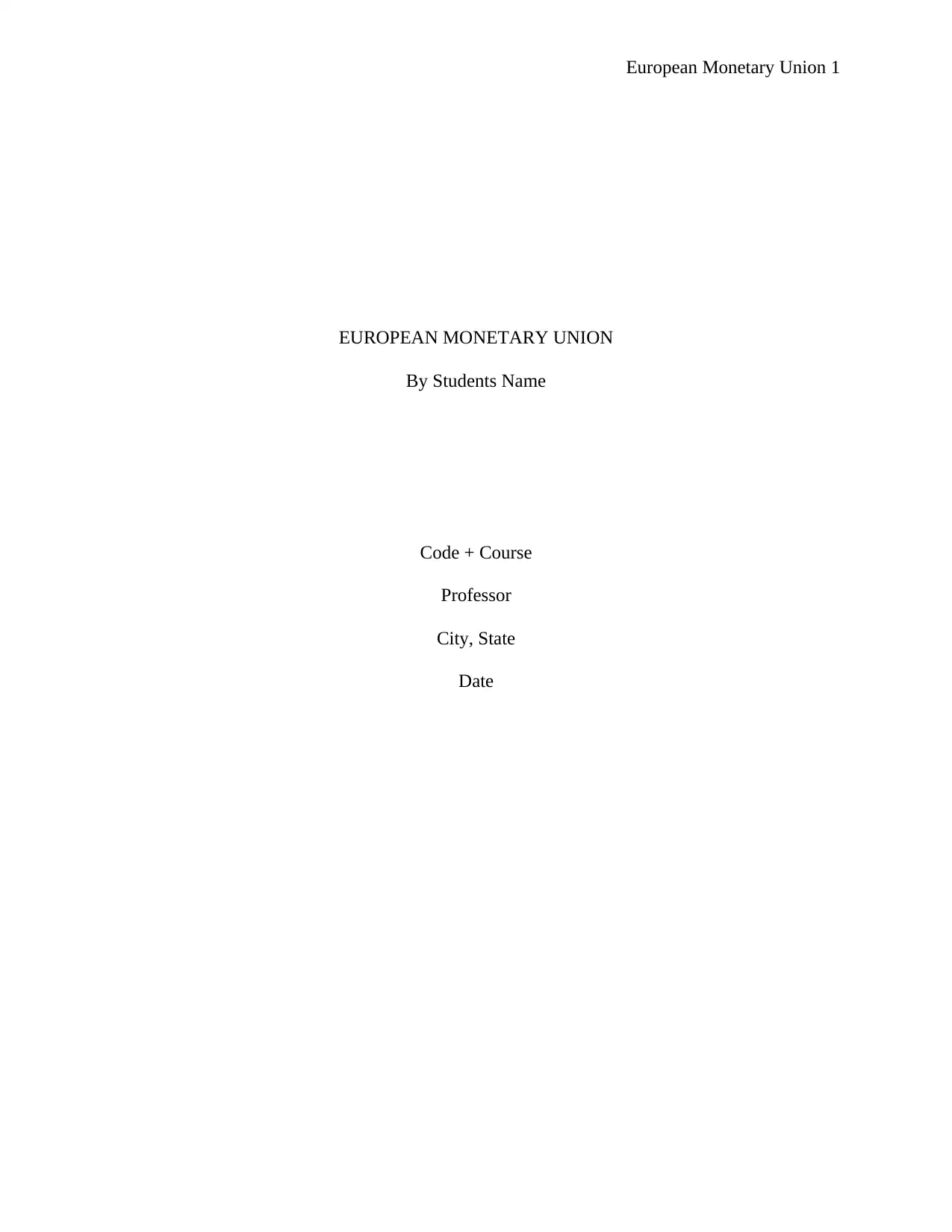
European Monetary Union 1
EUROPEAN MONETARY UNION
By Students Name
Code + Course
Professor
City, State
Date
EUROPEAN MONETARY UNION
By Students Name
Code + Course
Professor
City, State
Date
Paraphrase This Document
Need a fresh take? Get an instant paraphrase of this document with our AI Paraphraser
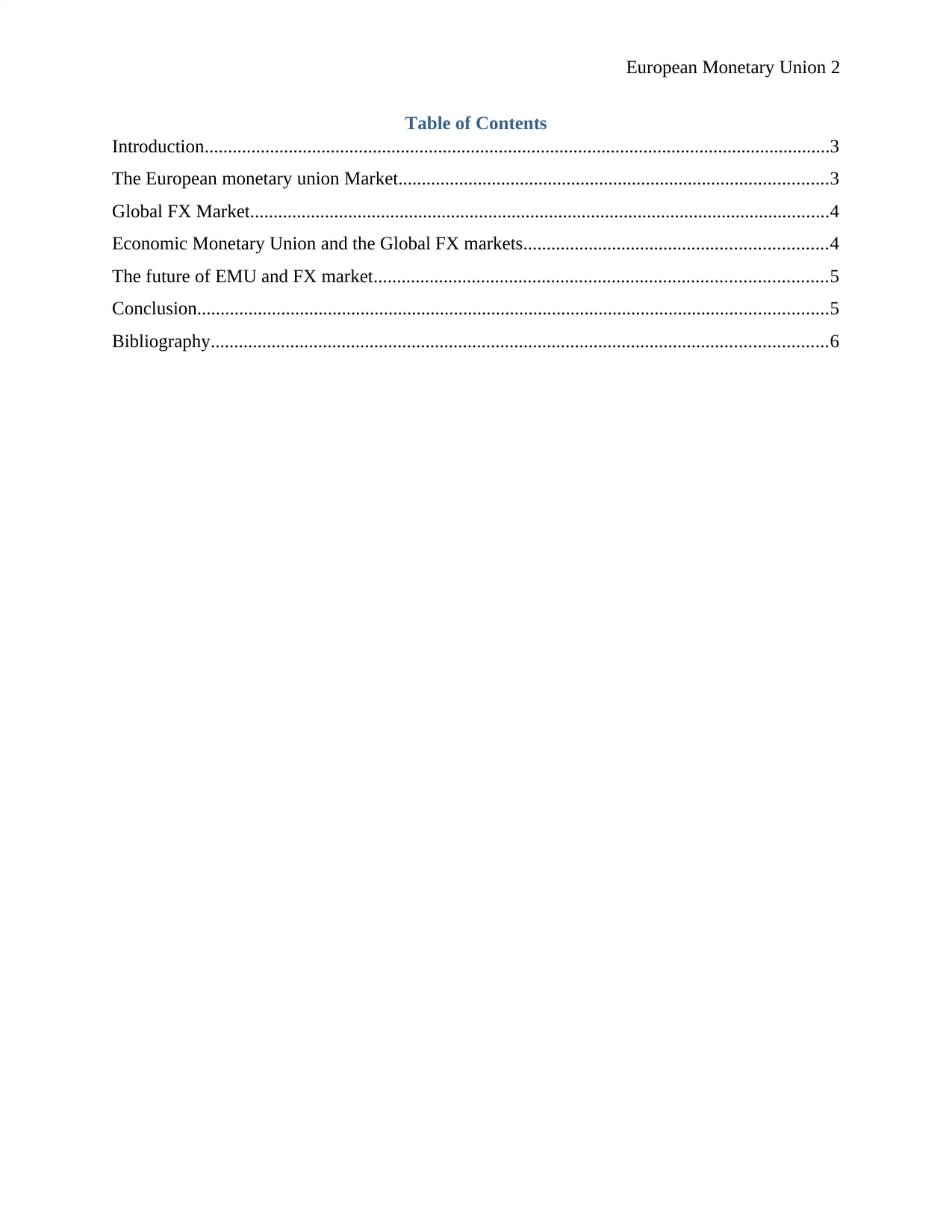
European Monetary Union 2
Table of Contents
Introduction......................................................................................................................................3
The European monetary union Market............................................................................................3
Global FX Market............................................................................................................................4
Economic Monetary Union and the Global FX markets.................................................................4
The future of EMU and FX market.................................................................................................5
Conclusion.......................................................................................................................................5
Bibliography....................................................................................................................................6
Table of Contents
Introduction......................................................................................................................................3
The European monetary union Market............................................................................................3
Global FX Market............................................................................................................................4
Economic Monetary Union and the Global FX markets.................................................................4
The future of EMU and FX market.................................................................................................5
Conclusion.......................................................................................................................................5
Bibliography....................................................................................................................................6
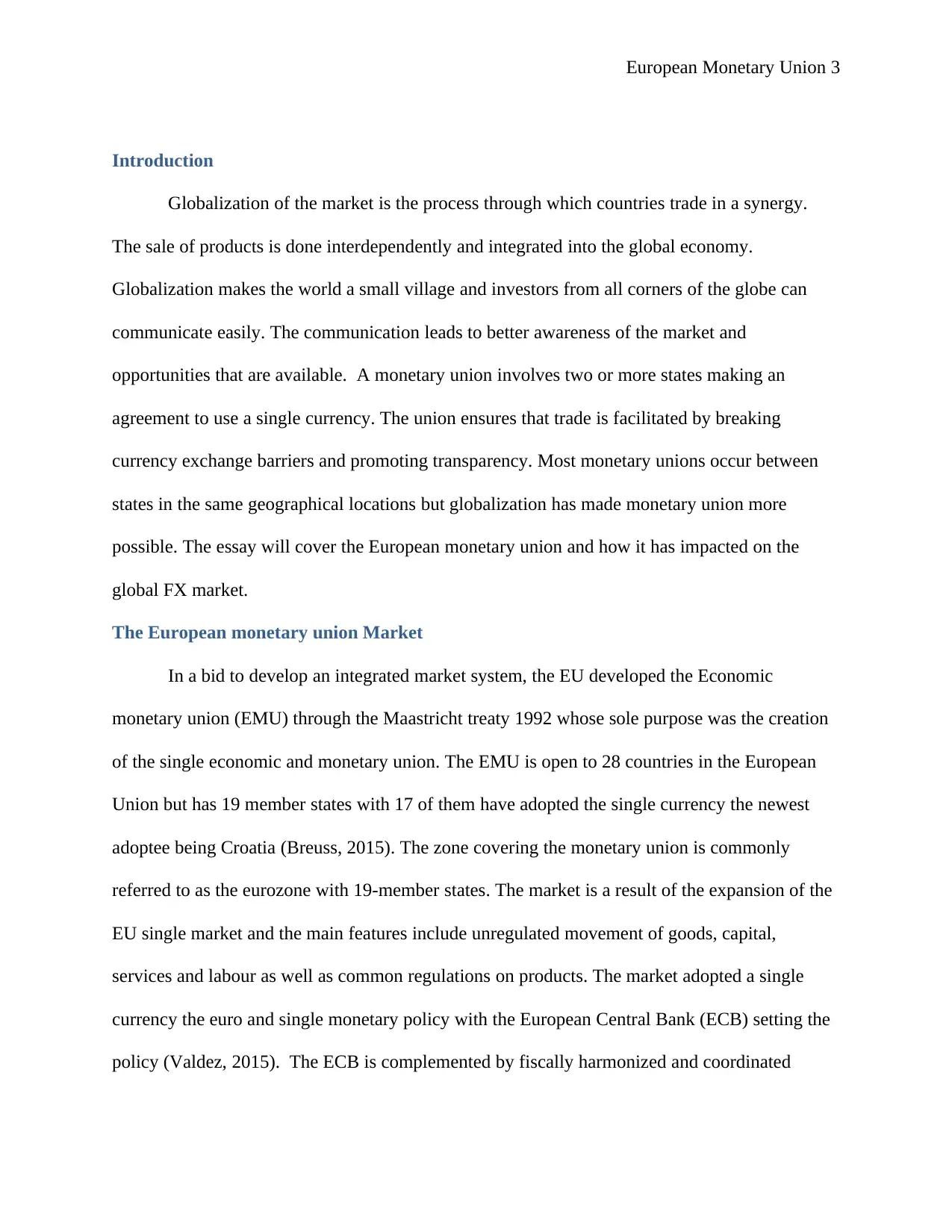
European Monetary Union 3
Introduction
Globalization of the market is the process through which countries trade in a synergy.
The sale of products is done interdependently and integrated into the global economy.
Globalization makes the world a small village and investors from all corners of the globe can
communicate easily. The communication leads to better awareness of the market and
opportunities that are available. A monetary union involves two or more states making an
agreement to use a single currency. The union ensures that trade is facilitated by breaking
currency exchange barriers and promoting transparency. Most monetary unions occur between
states in the same geographical locations but globalization has made monetary union more
possible. The essay will cover the European monetary union and how it has impacted on the
global FX market.
The European monetary union Market
In a bid to develop an integrated market system, the EU developed the Economic
monetary union (EMU) through the Maastricht treaty 1992 whose sole purpose was the creation
of the single economic and monetary union. The EMU is open to 28 countries in the European
Union but has 19 member states with 17 of them have adopted the single currency the newest
adoptee being Croatia (Breuss, 2015). The zone covering the monetary union is commonly
referred to as the eurozone with 19-member states. The market is a result of the expansion of the
EU single market and the main features include unregulated movement of goods, capital,
services and labour as well as common regulations on products. The market adopted a single
currency the euro and single monetary policy with the European Central Bank (ECB) setting the
policy (Valdez, 2015). The ECB is complemented by fiscally harmonized and coordinated
Introduction
Globalization of the market is the process through which countries trade in a synergy.
The sale of products is done interdependently and integrated into the global economy.
Globalization makes the world a small village and investors from all corners of the globe can
communicate easily. The communication leads to better awareness of the market and
opportunities that are available. A monetary union involves two or more states making an
agreement to use a single currency. The union ensures that trade is facilitated by breaking
currency exchange barriers and promoting transparency. Most monetary unions occur between
states in the same geographical locations but globalization has made monetary union more
possible. The essay will cover the European monetary union and how it has impacted on the
global FX market.
The European monetary union Market
In a bid to develop an integrated market system, the EU developed the Economic
monetary union (EMU) through the Maastricht treaty 1992 whose sole purpose was the creation
of the single economic and monetary union. The EMU is open to 28 countries in the European
Union but has 19 member states with 17 of them have adopted the single currency the newest
adoptee being Croatia (Breuss, 2015). The zone covering the monetary union is commonly
referred to as the eurozone with 19-member states. The market is a result of the expansion of the
EU single market and the main features include unregulated movement of goods, capital,
services and labour as well as common regulations on products. The market adopted a single
currency the euro and single monetary policy with the European Central Bank (ECB) setting the
policy (Valdez, 2015). The ECB is complemented by fiscally harmonized and coordinated
⊘ This is a preview!⊘
Do you want full access?
Subscribe today to unlock all pages.

Trusted by 1+ million students worldwide
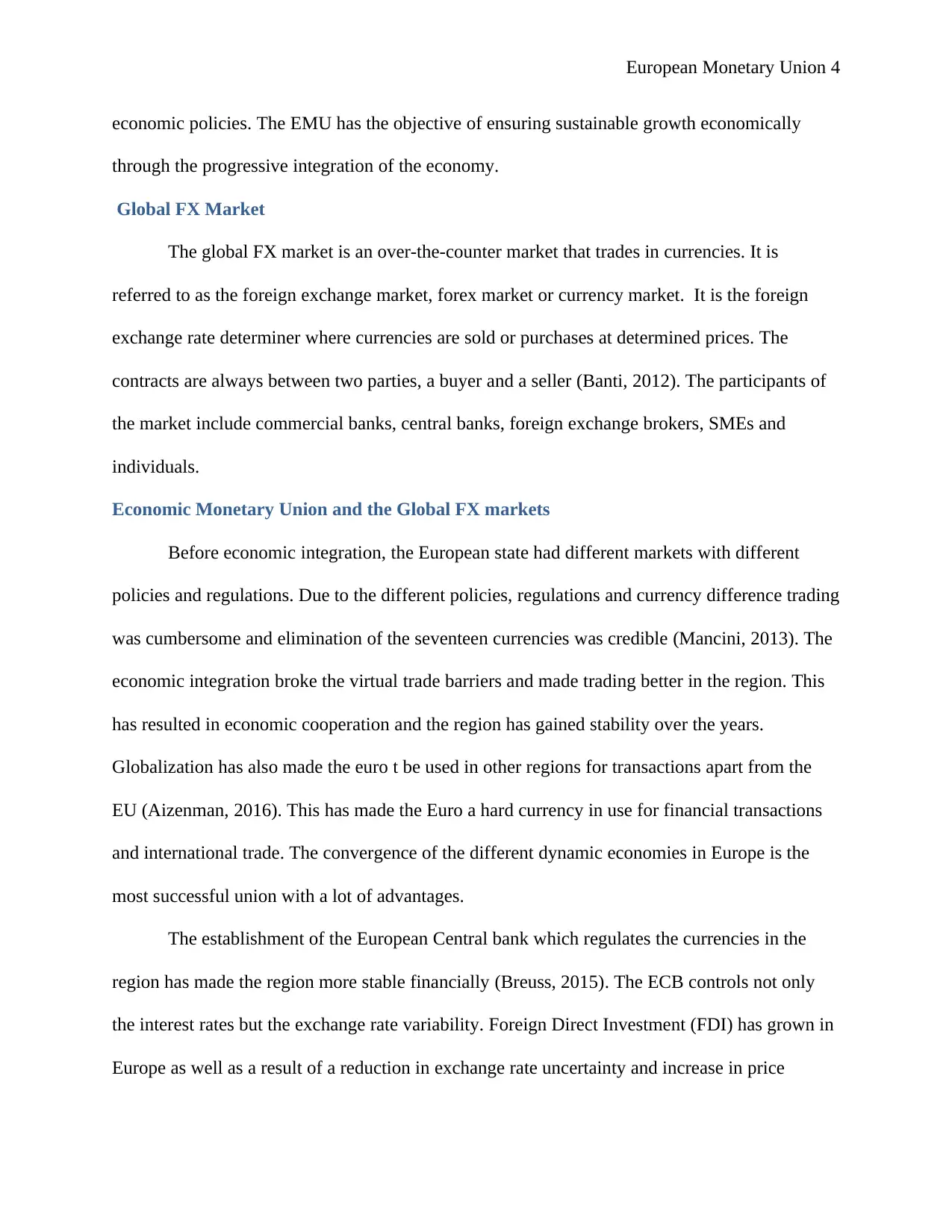
European Monetary Union 4
economic policies. The EMU has the objective of ensuring sustainable growth economically
through the progressive integration of the economy.
Global FX Market
The global FX market is an over-the-counter market that trades in currencies. It is
referred to as the foreign exchange market, forex market or currency market. It is the foreign
exchange rate determiner where currencies are sold or purchases at determined prices. The
contracts are always between two parties, a buyer and a seller (Banti, 2012). The participants of
the market include commercial banks, central banks, foreign exchange brokers, SMEs and
individuals.
Economic Monetary Union and the Global FX markets
Before economic integration, the European state had different markets with different
policies and regulations. Due to the different policies, regulations and currency difference trading
was cumbersome and elimination of the seventeen currencies was credible (Mancini, 2013). The
economic integration broke the virtual trade barriers and made trading better in the region. This
has resulted in economic cooperation and the region has gained stability over the years.
Globalization has also made the euro t be used in other regions for transactions apart from the
EU (Aizenman, 2016). This has made the Euro a hard currency in use for financial transactions
and international trade. The convergence of the different dynamic economies in Europe is the
most successful union with a lot of advantages.
The establishment of the European Central bank which regulates the currencies in the
region has made the region more stable financially (Breuss, 2015). The ECB controls not only
the interest rates but the exchange rate variability. Foreign Direct Investment (FDI) has grown in
Europe as well as a result of a reduction in exchange rate uncertainty and increase in price
economic policies. The EMU has the objective of ensuring sustainable growth economically
through the progressive integration of the economy.
Global FX Market
The global FX market is an over-the-counter market that trades in currencies. It is
referred to as the foreign exchange market, forex market or currency market. It is the foreign
exchange rate determiner where currencies are sold or purchases at determined prices. The
contracts are always between two parties, a buyer and a seller (Banti, 2012). The participants of
the market include commercial banks, central banks, foreign exchange brokers, SMEs and
individuals.
Economic Monetary Union and the Global FX markets
Before economic integration, the European state had different markets with different
policies and regulations. Due to the different policies, regulations and currency difference trading
was cumbersome and elimination of the seventeen currencies was credible (Mancini, 2013). The
economic integration broke the virtual trade barriers and made trading better in the region. This
has resulted in economic cooperation and the region has gained stability over the years.
Globalization has also made the euro t be used in other regions for transactions apart from the
EU (Aizenman, 2016). This has made the Euro a hard currency in use for financial transactions
and international trade. The convergence of the different dynamic economies in Europe is the
most successful union with a lot of advantages.
The establishment of the European Central bank which regulates the currencies in the
region has made the region more stable financially (Breuss, 2015). The ECB controls not only
the interest rates but the exchange rate variability. Foreign Direct Investment (FDI) has grown in
Europe as well as a result of a reduction in exchange rate uncertainty and increase in price
Paraphrase This Document
Need a fresh take? Get an instant paraphrase of this document with our AI Paraphraser
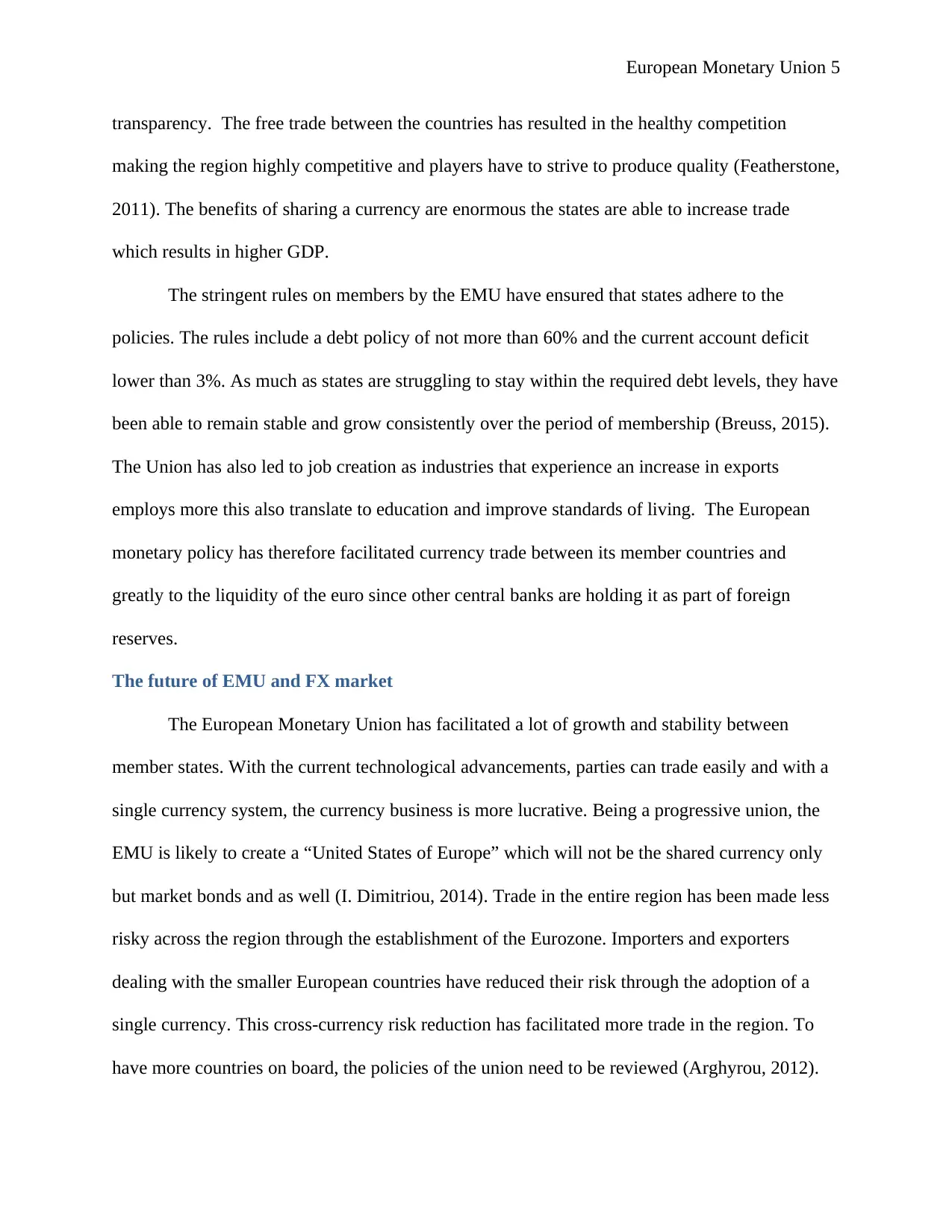
European Monetary Union 5
transparency. The free trade between the countries has resulted in the healthy competition
making the region highly competitive and players have to strive to produce quality (Featherstone,
2011). The benefits of sharing a currency are enormous the states are able to increase trade
which results in higher GDP.
The stringent rules on members by the EMU have ensured that states adhere to the
policies. The rules include a debt policy of not more than 60% and the current account deficit
lower than 3%. As much as states are struggling to stay within the required debt levels, they have
been able to remain stable and grow consistently over the period of membership (Breuss, 2015).
The Union has also led to job creation as industries that experience an increase in exports
employs more this also translate to education and improve standards of living. The European
monetary policy has therefore facilitated currency trade between its member countries and
greatly to the liquidity of the euro since other central banks are holding it as part of foreign
reserves.
The future of EMU and FX market
The European Monetary Union has facilitated a lot of growth and stability between
member states. With the current technological advancements, parties can trade easily and with a
single currency system, the currency business is more lucrative. Being a progressive union, the
EMU is likely to create a “United States of Europe” which will not be the shared currency only
but market bonds and as well (I. Dimitriou, 2014). Trade in the entire region has been made less
risky across the region through the establishment of the Eurozone. Importers and exporters
dealing with the smaller European countries have reduced their risk through the adoption of a
single currency. This cross-currency risk reduction has facilitated more trade in the region. To
have more countries on board, the policies of the union need to be reviewed (Arghyrou, 2012).
transparency. The free trade between the countries has resulted in the healthy competition
making the region highly competitive and players have to strive to produce quality (Featherstone,
2011). The benefits of sharing a currency are enormous the states are able to increase trade
which results in higher GDP.
The stringent rules on members by the EMU have ensured that states adhere to the
policies. The rules include a debt policy of not more than 60% and the current account deficit
lower than 3%. As much as states are struggling to stay within the required debt levels, they have
been able to remain stable and grow consistently over the period of membership (Breuss, 2015).
The Union has also led to job creation as industries that experience an increase in exports
employs more this also translate to education and improve standards of living. The European
monetary policy has therefore facilitated currency trade between its member countries and
greatly to the liquidity of the euro since other central banks are holding it as part of foreign
reserves.
The future of EMU and FX market
The European Monetary Union has facilitated a lot of growth and stability between
member states. With the current technological advancements, parties can trade easily and with a
single currency system, the currency business is more lucrative. Being a progressive union, the
EMU is likely to create a “United States of Europe” which will not be the shared currency only
but market bonds and as well (I. Dimitriou, 2014). Trade in the entire region has been made less
risky across the region through the establishment of the Eurozone. Importers and exporters
dealing with the smaller European countries have reduced their risk through the adoption of a
single currency. This cross-currency risk reduction has facilitated more trade in the region. To
have more countries on board, the policies of the union need to be reviewed (Arghyrou, 2012).
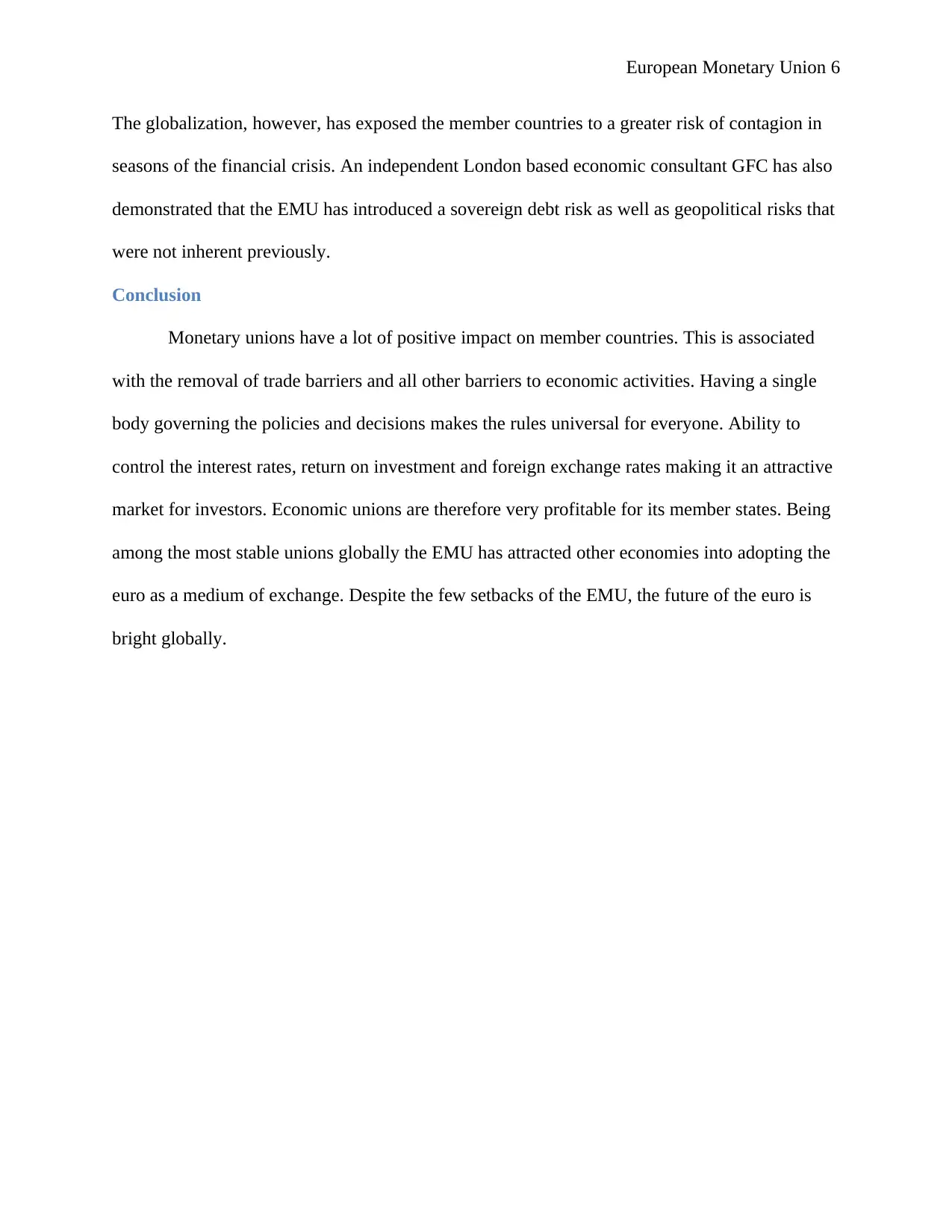
European Monetary Union 6
The globalization, however, has exposed the member countries to a greater risk of contagion in
seasons of the financial crisis. An independent London based economic consultant GFC has also
demonstrated that the EMU has introduced a sovereign debt risk as well as geopolitical risks that
were not inherent previously.
Conclusion
Monetary unions have a lot of positive impact on member countries. This is associated
with the removal of trade barriers and all other barriers to economic activities. Having a single
body governing the policies and decisions makes the rules universal for everyone. Ability to
control the interest rates, return on investment and foreign exchange rates making it an attractive
market for investors. Economic unions are therefore very profitable for its member states. Being
among the most stable unions globally the EMU has attracted other economies into adopting the
euro as a medium of exchange. Despite the few setbacks of the EMU, the future of the euro is
bright globally.
The globalization, however, has exposed the member countries to a greater risk of contagion in
seasons of the financial crisis. An independent London based economic consultant GFC has also
demonstrated that the EMU has introduced a sovereign debt risk as well as geopolitical risks that
were not inherent previously.
Conclusion
Monetary unions have a lot of positive impact on member countries. This is associated
with the removal of trade barriers and all other barriers to economic activities. Having a single
body governing the policies and decisions makes the rules universal for everyone. Ability to
control the interest rates, return on investment and foreign exchange rates making it an attractive
market for investors. Economic unions are therefore very profitable for its member states. Being
among the most stable unions globally the EMU has attracted other economies into adopting the
euro as a medium of exchange. Despite the few setbacks of the EMU, the future of the euro is
bright globally.
⊘ This is a preview!⊘
Do you want full access?
Subscribe today to unlock all pages.

Trusted by 1+ million students worldwide
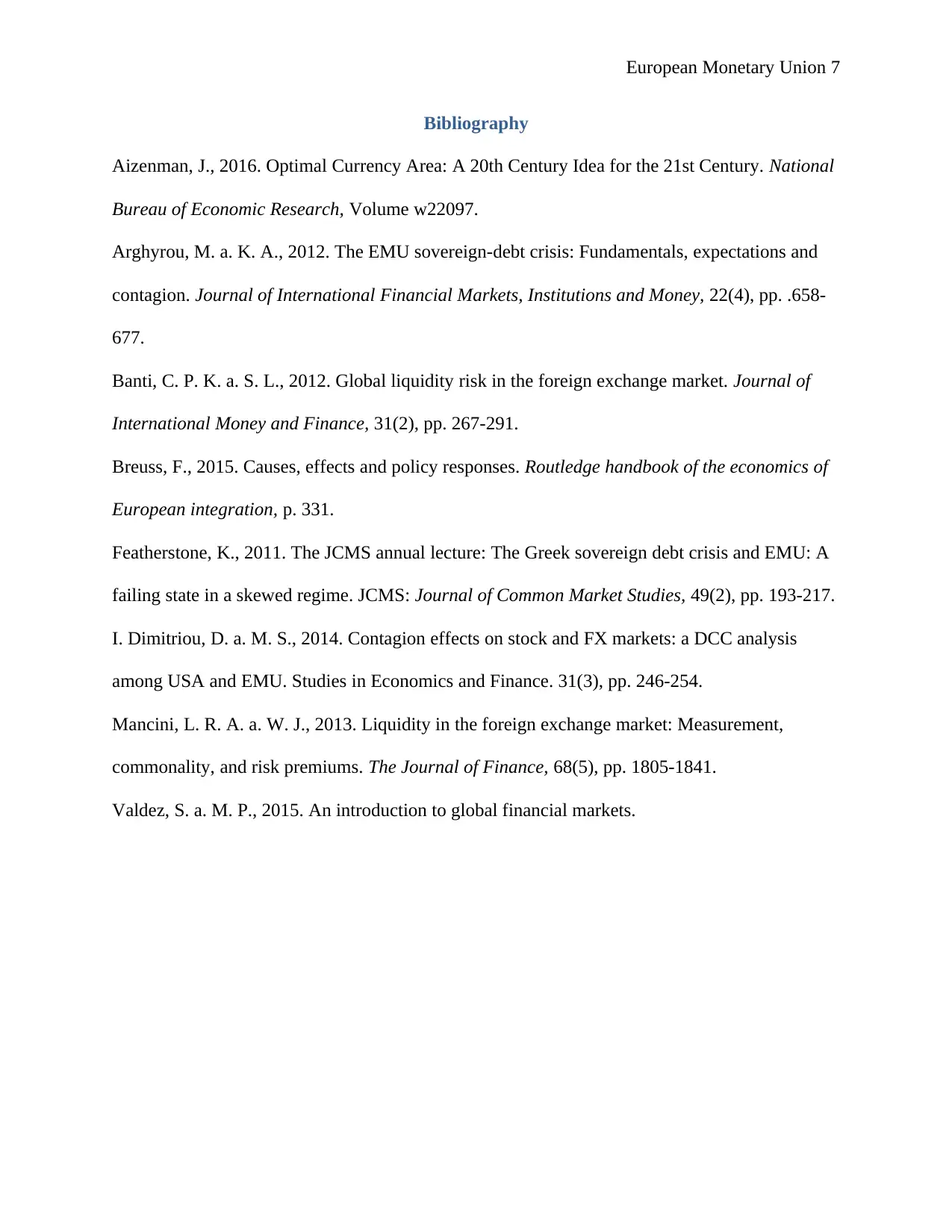
European Monetary Union 7
Bibliography
Aizenman, J., 2016. Optimal Currency Area: A 20th Century Idea for the 21st Century. National
Bureau of Economic Research, Volume w22097.
Arghyrou, M. a. K. A., 2012. The EMU sovereign-debt crisis: Fundamentals, expectations and
contagion. Journal of International Financial Markets, Institutions and Money, 22(4), pp. .658-
677.
Banti, C. P. K. a. S. L., 2012. Global liquidity risk in the foreign exchange market. Journal of
International Money and Finance, 31(2), pp. 267-291.
Breuss, F., 2015. Causes, effects and policy responses. Routledge handbook of the economics of
European integration, p. 331.
Featherstone, K., 2011. The JCMS annual lecture: The Greek sovereign debt crisis and EMU: A
failing state in a skewed regime. JCMS: Journal of Common Market Studies, 49(2), pp. 193-217.
I. Dimitriou, D. a. M. S., 2014. Contagion effects on stock and FX markets: a DCC analysis
among USA and EMU. Studies in Economics and Finance. 31(3), pp. 246-254.
Mancini, L. R. A. a. W. J., 2013. Liquidity in the foreign exchange market: Measurement,
commonality, and risk premiums. The Journal of Finance, 68(5), pp. 1805-1841.
Valdez, S. a. M. P., 2015. An introduction to global financial markets.
Bibliography
Aizenman, J., 2016. Optimal Currency Area: A 20th Century Idea for the 21st Century. National
Bureau of Economic Research, Volume w22097.
Arghyrou, M. a. K. A., 2012. The EMU sovereign-debt crisis: Fundamentals, expectations and
contagion. Journal of International Financial Markets, Institutions and Money, 22(4), pp. .658-
677.
Banti, C. P. K. a. S. L., 2012. Global liquidity risk in the foreign exchange market. Journal of
International Money and Finance, 31(2), pp. 267-291.
Breuss, F., 2015. Causes, effects and policy responses. Routledge handbook of the economics of
European integration, p. 331.
Featherstone, K., 2011. The JCMS annual lecture: The Greek sovereign debt crisis and EMU: A
failing state in a skewed regime. JCMS: Journal of Common Market Studies, 49(2), pp. 193-217.
I. Dimitriou, D. a. M. S., 2014. Contagion effects on stock and FX markets: a DCC analysis
among USA and EMU. Studies in Economics and Finance. 31(3), pp. 246-254.
Mancini, L. R. A. a. W. J., 2013. Liquidity in the foreign exchange market: Measurement,
commonality, and risk premiums. The Journal of Finance, 68(5), pp. 1805-1841.
Valdez, S. a. M. P., 2015. An introduction to global financial markets.
1 out of 7
Related Documents
Your All-in-One AI-Powered Toolkit for Academic Success.
+13062052269
info@desklib.com
Available 24*7 on WhatsApp / Email
![[object Object]](/_next/static/media/star-bottom.7253800d.svg)
Unlock your academic potential
Copyright © 2020–2025 A2Z Services. All Rights Reserved. Developed and managed by ZUCOL.





